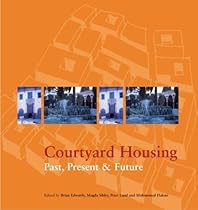

Courtyard housing is one of the oldest forms of domestic development spanning at least 2000 years and occurring in distinctive form in many regions of the world. Traditionally associated with the Middle East where climate and culture have given shape to a particular type of courtyard housing; other examples exist in Latin America; China and in Europe; where the model has been reinterpreted. This book demonstrates; through discussions on sustainability and regional identity; and via a series of case studies; technical planning and design solutions; that the courtyard housing form has a future as well as a past.
#3350970 in eBooks 2004-08-02 2004-08-02File Name: B000Q36U1Y
Review
6 of 6 people found the following review helpful. Four and a Half StarsBy Michael N. RyanA delightful book. Each house mentioned is accompanied by a well writtein single paragraph that describes it beutfifully and even adds suggestions on how to build it such as putting the kitchen in the basement which is brilliant for a time before air conditioning. However it only provides two floors of plan rather than a full set. No plans for attic or basement which is a shame. Design XXXV no floor plans at all.Otherwise great for those interested i archiecture or the history of the victorian period.A joy.17 of 17 people found the following review helpful. A visual feast for the home architecture aficionadoBy Michael J. MazzaDover Publications has done an outstanding service in reprinting home plan books of past eras; and S.B. Reeds "Victorian Dwellings for Village and Country" is one of the best. A complete reproduction of the 1885 edition of this book; the Dover reprint is a fascinating and beautiful glimpse into one of home architectures richest eras.The plan of the book is simple and informative. It is a collection of 35 marvelously detailed designs for homes that range from a humble three-room cottage to an imposing boarding house. Each selection contains front and side (and in some cases; rear) elevations; along with floor plans for the first and (for the 2- and 3-story buildings) second stories. Each building is accompanied by a charming descriptive essay and a detailed estimate of the 1885 cost to build it.The building plans bear such picturesque names as "Lillie Lake;" "Willimantic;" "Ravenswood;" and "Stepping Stones." Interspersed among the design profiles are a few short essays on such relevant topics as plumbing and building cost estimation.The Victorian language of the descriptive essays is a delight. Consider this description of the New Brighton (Design XV): "It has a tasty and picturesque exterior; and is convenient; cosey [sic] and cheerful within." But even more delightful are the floor plans and elevations. Covered verandas; inglenooks; decorative trim; towers and balconies--the full extravagant vocabulary of Victorian architecture is gloriously preserved.This book will be treasured by historians; old house restorationists; artists; students of architecture and many more.